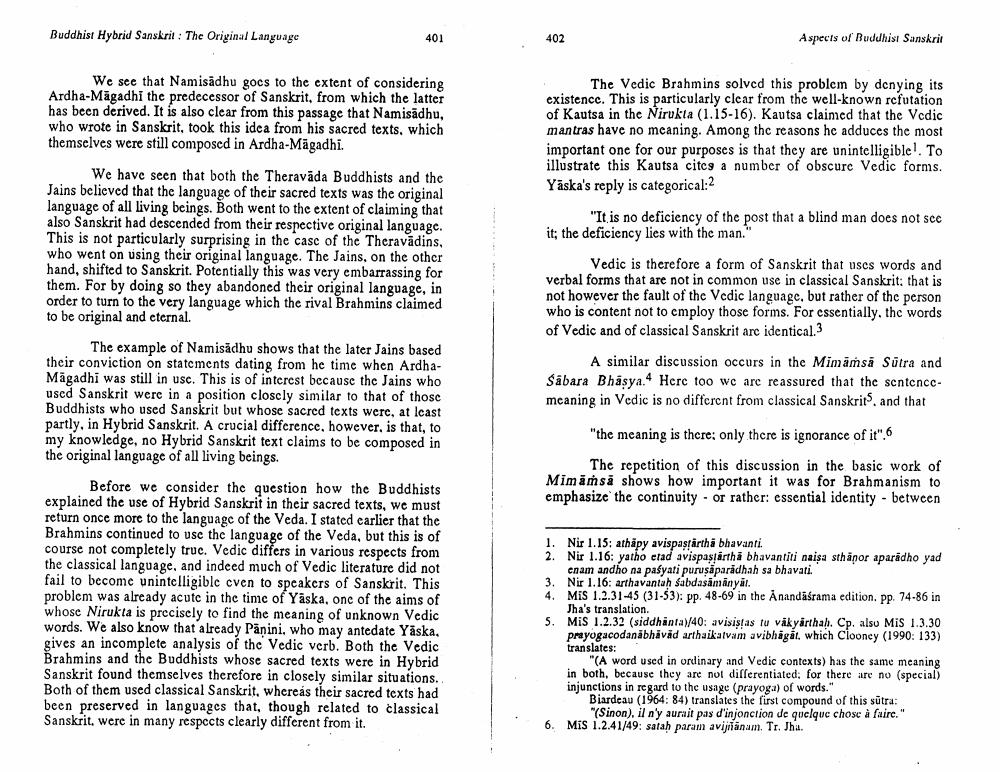Book Title: Buddhist Hybrid Sanskrit Original Language Author(s): Johannes Bronkhorst Publisher: Johannes Bronkhorst View full book textPage 4
________________ Buddhist Hybrid Sanskrit: The Original Language 401 402 Aspects of Buddhist Sanskrit We see that Namisadhu goes to the extent of considering Ardha-Māgadhi the predecessor of Sanskrit, from which the latter has been derived. It is also clear from this passage that Namisādhu, who wrote in Sanskrit, took this idea from his sacred texts, which themselves were still composed in Ardha-Magadhi. We have seen that both the Theravada Buddhists and the Jains believed that the language of their sacred texts was the original language of all living beings. Both went to the extent of claiming that also Sanskrit had descended from their respective original language. This is not particularly surprising in the case of the Theravādins, who went on using their original language. The Jains, on the other hand, shifted to Sanskrit. Potentially this was very embarrassing for them. For by doing so they abandoned their original language, in order to turn to the very language which the rival Brahmins claimed to be original and eternal. The Vedic Brahmins solved this problem by denying its existence. This is particularly clear from the well-known refutation of Kautsa in the Nirukla (1.15-16). Kautsa claimed that the Vedic mantras have no mcaning. Among the reasons he adduces the most important one for our purposes is that they are unintelligible!. To illustrate this Kautsa cites a number of obscure Vedic forms. Yaska's reply is categorical:2 "It is no deficiency of the post that a blind man does not sce it; the deficiency lies with the man." Vedic is therefore a form of Sanskrit that uses words and verbal forms that are not in common use in classical Sanskrit: that is not however the fault of the Vedic language, but rather of the person who is content not to employ those forms. For essentially, the words of Vedic and of classical Sanskrit are identical.3 A similar discussion occurs in the Mimāmsá Sūtra and Sabara Bhasya. Here too we are reassured that the sentencemeaning in Vedic is no different from classical Sanskrits, and that The example of Namisådhu shows that the later Jains based their conviction on statements dating from he time when ArdhaMagadhi was still in use. This is of interest because the Jains who used Sanskrit were in a position closely similar to that of those Buddhists who used Sanskrit but whose sacred texts were, at least partly, in Hybrid Sanskrit. A crucial difference, however, is that, to my knowledge, no Hybrid Sanskrit text claims to be composed in the original language of all living beings. "the meaning is there; only there is ignorance of it". The repetition of this discussion in the basic work of Mimāṁsā shows how important it was for Brahmanism to emphasize the continuity or rather: essential identity - between Before we consider the question how the Buddhists explained the use of Hybrid Sanskrit in their sacred texts, we must return once more to the language of the Veda. I stated earlier that the Brahmins continued to use the language of the Veda, but this is of course not completely truc. Vedic differs in various respects from the classical language, and indeed much of Vedic literature did not fail to become unintelligible cven to speakers of Sanskrit. This problem was already acute in the time of Yaska, one of the aims of whose Nirukta is precisely to find the meaning of unknown Vedic words. We also know that already Panini, who may antedate Yaska. gives an incomplete analysis of the Vedic verb. Both the Vedic Brahmins and the Buddhists whose sacred texts were in Hybrid Sanskrit found themselves therefore in closely similar situations. Both of them used classical Sanskrit, whereas their sacred texts had been preserved in languages that, though related to classical Sanskrit were in many respects clearly different from it. 1. Nir 1.15: athäpy avispasrartha bhavanti 2. Nir 1.16: yatho etad avispastartha bhavantiti naisa sthapor aparadho yad enam andho na paśyati purusaparidhah sa bhavati. 3. Nir 1.16: arthavantah Sabdasāmányal. 4. Mis 1.2.31-45 (31-53): pp. 48-69 in the Anandāśrama edition. Pp. 74-86 in Jha's translation. 5. Mis 1.2.32 (siddhanta)/40: avisistas tu vikyarthah. Cp, alsu MIS 1.3.30 prayogacodanabhävid arthaikatvam avibhagal, which Clooney (1990: 133) translates: "(A word used in ordinary and Vedic contexts) has the same meaning in both, because they are not differentiated, for there are no (special) injunctions in regard to the usage (prayoga) of words." 84) translates the first compound of this sutra: "(Sinon), il n'y aurait pas d'injonction de quelque chose à faire." 6. Mis 1.2.41/49: salah param aviānam. Tr. Jha.Page Navigation
1 2 3 4 5 6 7 8 9 10 11 12 13 14 15
